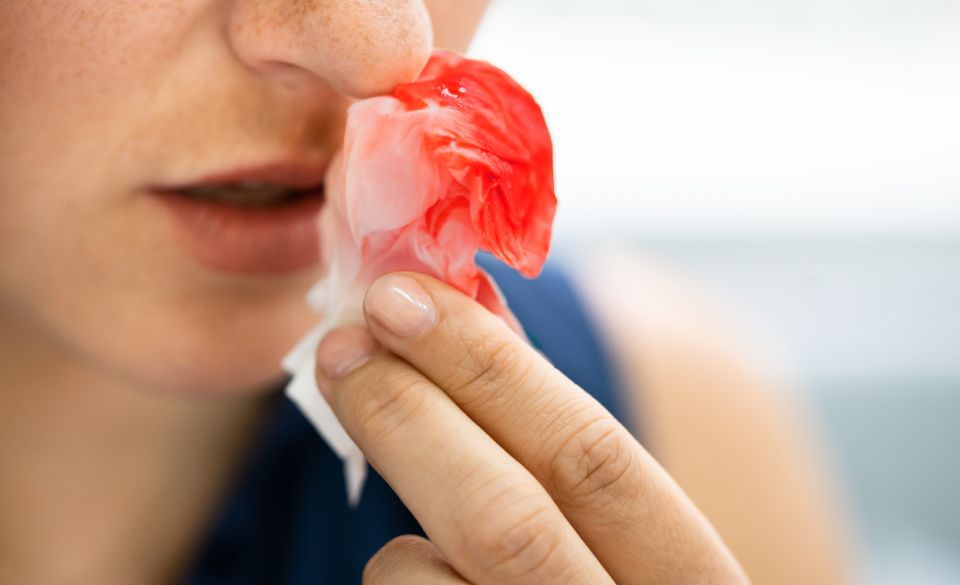
Nosebleed While Working Out: Causes, Treatment & More
Page Contents
Picture this: You’re in the midst of an invigorating workout, pushing your limits and feeling the rush of endorphins. Suddenly, a nosebleed makes an unexpected appearance. Before you hit the panic button, let’s unravel the mystery behind nosebleeds during workouts—why they happen, how to treat them, and how to prevent them from dampening your fitness journey.
The Workout Surprise: Causes of Nosebleeds
You’re in the zone, conquering your workout goals with determination, and suddenly—bam! A nosebleed takes center stage, throwing you off your game. While it might seem like a puzzling interruption, there’s a science behind the curtain. Let’s delve into the causes of those unexpected nosebleeds during your sweat sessions and shed light on why they occasionally join the workout party.
Blood Pressure Spikes: The Sudden Surge
Picture this scenario: You’re engaged in an intense cardio session, the heart rate is up, and your blood is pumping with fervor. This heightened cardiovascular activity leads to a temporary surge in blood pressure. As your heart pumps blood more vigorously to supply oxygen to your working muscles, the blood vessels within your nasal passages experience increased pressure. This surge in pressure can sometimes push these delicate vessels over the edge, resulting in a nosebleed mid-workout.
Dehydration Drama: Dryness Takes the Spotlight
Another contributing actor in the nosebleed saga is dehydration. Intense workouts, especially in environments with low humidity, can strip your body of its precious fluids. The result? Dry nasal passages that are more susceptible to irritation and bleeding. Dryness weakens the blood vessels lining your nose, making them more fragile and prone to rupture. So, if you’re sweating it out without replenishing those fluids, your nasal passages might sound the alarm in the form of a nosebleed.
Allergies Amplified: Inflammation at Play
If you’re no stranger to seasonal allergies, they might play a supporting role in the nosebleed narrative. Allergic reactions often lead to inflammation and congestion of nasal tissues. This swelling narrows the passageways and increases pressure within the blood vessels. When you add the extra pressure from your workout’s blood-pumping effects, it can tip the scales and trigger a nosebleed. It’s like a perfect storm brewing within your nasal passages, and exercise can sometimes be the catalyst that sets it in motion.
Your Body’s Warning Sign: Listen Up!
While nosebleeds during workouts can catch you off guard, they’re not always random events. They might be your body’s way of signaling potential imbalances or overexertion. Pay attention to the frequency and severity of these nosebleeds. If they become a recurring theme, it’s essential to take a step back, evaluate your hydration and warm-up routines, and consider consulting a healthcare professional to rule out any underlying concerns.
Quick Fixes and Treatment For A Bleed Nose While Working Out
While a nosebleed mid-workout might catch you off guard, knowing how to handle it swiftly and effectively can help you get back on track. Let’s explore some quick fixes and treatments that can come to your rescue when a nosebleed decides to join your workout session.
1. Stay Calm and Pause:
First things first, don’t panic. While a nosebleed during exercise can be surprising, staying calm is essential. Gently stop your workout and take a moment to assess the situation. Leaning slightly forward can prevent blood from flowing down your throat.
2. Pinch and Pressure:
The classic pinch-and-pressure technique works wonders to stop a nosebleed. Use your thumb and index finger to pinch your nostrils together. Apply steady pressure for about 10-15 minutes. This encourages the blood vessels to constrict and aids in clot formation, stemming the bleeding.
3. Cold Compress:
Reach for a cold compress or ice pack and place it on the bridge of your nose. The cold temperature helps constrict blood vessels, reducing the blood flow and aiding in clot formation. Remember to wrap the compress in a cloth to avoid direct contact with your skin.
4. Hydrate and Moisturize:
Dehydration can exacerbate nosebleeds, especially during exercise. Ensure you’re well-hydrated before and during your workout. If you’re prone to nosebleeds, consider using a saline nasal spray before your workout to keep your nasal passages moist and less susceptible to irritation.
5. Seek Medical Attention if Needed:
If the nosebleed persists beyond 15 minutes or if it’s particularly heavy, it’s wise to seek medical attention. Additionally, if the nosebleed is accompanied by dizziness, lightheadedness, or other concerning symptoms, pause your workout and consult a healthcare professional.
6. Avoid Forceful Nose Blowing:
After the nosebleed has stopped, avoid forcefully blowing your nose. This can irritate the nasal passages and potentially trigger another bleed. Instead, gently blow your nose if needed.
7. Monitor for Recurrence:
Keep an eye on the frequency and recurrence of nosebleeds during your workouts. If they become a recurring issue, it’s essential to consult a medical professional. They can help identify any underlying factors contributing to the nosebleeds and provide guidance on preventive measures.
Strategies for Nose Bleed Prevention
Nosebleeds during workouts can be unwelcome guests, but with a few proactive strategies, you can reduce their likelihood and ensure a smoother fitness experience. If you’re tired of interruptions mid-burpee, here are some effective strategies to help you prevent those exercise-induced nosebleeds and keep your workouts on track.
1. Hydration: The Ultimate Ally
Staying well-hydrated is not only crucial for your overall health but also plays a significant role in preventing nosebleeds. Proper hydration helps maintain the moisture levels in your nasal passages, reducing the risk of irritation and dryness. Make it a habit to drink water before, during, and after your workout sessions. Adequate hydration supports the health of your blood vessels and helps maintain their integrity.
2. Gentle Nose Care:
Avoid aggressive nose blowing, especially before and after workouts. Forceful blowing can irritate the delicate blood vessels in your nasal passages, making them more susceptible to bleeding. Instead, opt for gentle blowing or use a saline nasal spray to clear your nasal passages without causing undue stress.
3. Pre-Workout Warm-Up:
Just as you warm up your muscles, warming up your nasal passages can help prevent nosebleeds. Before diving into your workout, consider inhaling gently through your nose and exhaling through your mouth. This gradual warm-up can prepare your nasal passages for the increased airflow that comes with exercise.
4. Proper Cool-Down:
A proper cool-down post-workout is not just about stretching—it also extends to your nasal passages. As you wind down your workout, take a few moments to relax and breathe gently through your nose. This can help your nasal passages adjust to the shift in airflow and prevent abrupt changes that might trigger bleeding.
5. Moisturizing Nasal Spray:
Consider using a saline nasal spray before and after your workouts. These sprays help maintain the moisture levels in your nasal passages, reducing dryness and irritation. Opt for preservative-free saline sprays for a gentle and effective solution.
6. Allergy Management:
If you suffer from allergies, managing them effectively can go a long way in preventing exercise-induced nosebleeds. Allergies often lead to inflammation and congestion of nasal tissues, making them more vulnerable to bleeding during exercise. Consult a healthcare professional for guidance on managing your allergies and minimizing their impact.
7. Gradual Transitions:
If you’re switching between indoor and outdoor environments or between different climates, give your body time to adapt. Sudden changes in temperature and humidity can contribute to dryness and irritation. Gradually transitioning from one environment to another allows your nasal passages to adjust without undue stress.
Conclusion: Listen to Your Body
Experiencing a nosebleed during a workout might seem like a curveball, but understanding its causes and employing preventive measures can put you back in control. As you embark on your fitness journey, remember that your body communicates its needs and limits. If nosebleeds become a recurrent issue, it’s crucial to consult a medical professional to rule out underlying concerns.
In the grand tapestry of your workout routine, a nosebleed is just a stitch—a momentary inconvenience that can be managed with grace and knowledge. So, keep those tissues handy, hydrate diligently, and let your body be your guide as you pursue your fitness aspirations.



